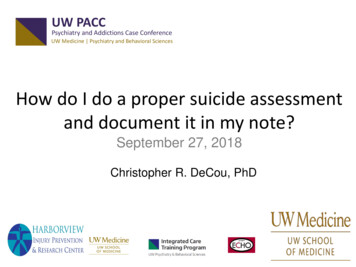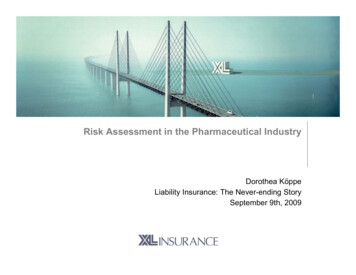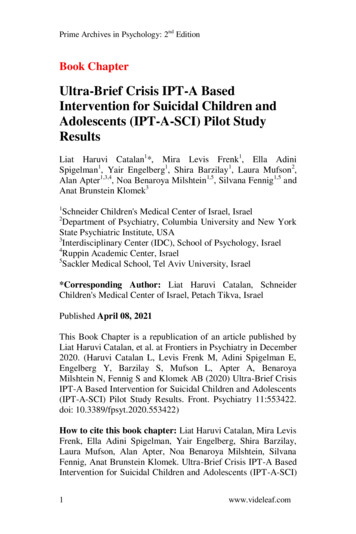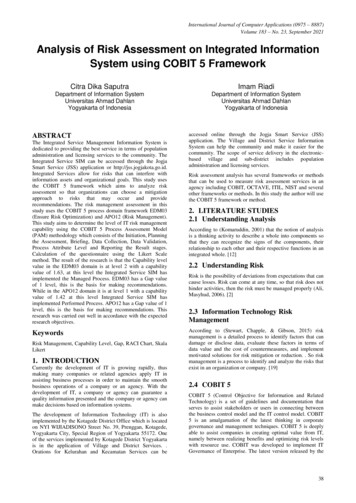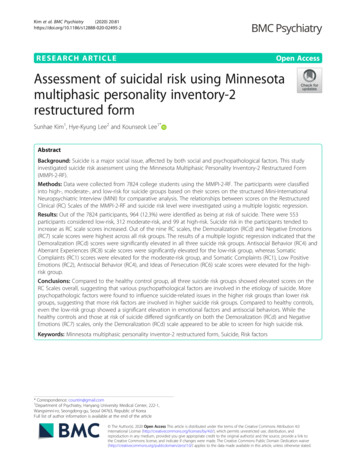
Transcription
Kim et al. BMC Psychiatry(2020) EARCH ARTICLEOpen AccessAssessment of suicidal risk using Minnesotamultiphasic personality inventory-2restructured formSunhae Kim1, Hye-Kyung Lee2 and Kounseok Lee1*AbstractBackground: Suicide is a major social issue, affected by both social and psychopathological factors. This studyinvestigated suicide risk assessment using the Minnesota Multiphasic Personality Inventory-2 Restructured Form(MMPI-2-RF).Methods: Data were collected from 7824 college students using the MMPI-2-RF. The participants were classifiedinto high-, moderate-, and low-risk for suicide groups based on their scores on the structured Mini-InternationalNeuropsychiatric Interview (MINI) for comparative analysis. The relationships between scores on the RestructuredClinical (RC) Scales of the MMPI-2-RF and suicide risk level were investigated using a multiple logistic regression.Results: Out of the 7824 participants, 964 (12.3%) were identified as being at risk of suicide. There were 553participants considered low-risk, 312 moderate-risk, and 99 at high-risk. Suicide risk in the participants tended toincrease as RC scale scores increased. Out of the nine RC scales, the Demoralization (RCd) and Negative Emotions(RC7) scale scores were highest across all risk groups. The results of a multiple logistic regression indicated that theDemoralization (RCd) scores were significantly elevated in all three suicide risk groups. Antisocial Behavior (RC4) andAberrant Experiences (RC8) scale scores were significantly elevated for the low-risk group, whereas SomaticComplaints (RC1) scores were elevated for the moderate-risk group, and Somatic Complaints (RC1), Low PositiveEmotions (RC2), Antisocial Behavior (RC4), and Ideas of Persecution (RC6) scale scores were elevated for the highrisk group.Conclusions: Compared to the healthy control group, all three suicide risk groups showed elevated scores on theRC Scales overall, suggesting that various psychopathological factors are involved in the etiology of suicide. Morepsychopathologic factors were found to influence suicide-related issues in the higher risk groups than lower riskgroups, suggesting that more risk factors are involved in higher suicide risk groups. Compared to healthy controls,even the low-risk group showed a significant elevation in emotional factors and antisocial behaviors. While thehealthy controls and those at risk of suicide differed significantly on both the Demoralization (RCd) and NegativeEmotions (RC7) scales, only the Demoralization (RCd) scale appeared to be able to screen for high suicide risk.Keywords: Minnesota multiphasic personality inventor-2 restructured form, Suicide, Risk factors* Correspondence: countin@gmail.com1Department of Psychiatry, Hanyang University Medical Center, 222-1,Wangsimni-ro, Seongdong-gu, Seoul 04763, Republic of KoreaFull list of author information is available at the end of the article The Author(s). 2020 Open Access This article is distributed under the terms of the Creative Commons Attribution 4.0International License (http://creativecommons.org/licenses/by/4.0/), which permits unrestricted use, distribution, andreproduction in any medium, provided you give appropriate credit to the original author(s) and the source, provide a link tothe Creative Commons license, and indicate if changes were made. The Creative Commons Public Domain Dedication o/1.0/) applies to the data made available in this article, unless otherwise stated.
Kim et al. BMC Psychiatry(2020) 20:81BackgroundAccording to health statistics released by the Organizationfor Economic Co-operation and Development (OECD) in2018, Korea ranked second with 53.0 suicides per 100,000people in 2017, and according to the OECD age-adjustedsuicide rate, Korea again ranked second with 23.0 suicides(per 100,000 of the OECD standard population) [1]. Because of national policies and interventions to reduce therate of suicide, which is a serious cause of death in Korea,the number of suicides decreased by 4.8% in 2017 whencompared with the number in 2016. However, the suiciderate for those under the age of 15 years increased by 66.7%in the same year, and suicide has remained the top causeof death among teenagers and those in their 20s and 30s.Unfortunately, the suicide mortality rate in Korea, whichhad been declining steadily over the past few years, increased by 2.3 suicides (9.5%) in 2018 when comparedwith the value in 2017. Compared with the OECD averageage-adjusted suicide rate of 11.5, Korea recorded a higherrate of 24.7, ranking at the top among OECD countries. Inparticular, the suicide rate increased in individuals of allages, except those aged 80 years or older, and it was highin teenagers (22.1%) and those in their 40s (13.1%) and30s (12.2%) [1]. Considering that a history of suicidal ideation and/or suicidal attempt is the biggest risk factor forsuicide, youth with a history of suicidal behavior present ahigh-risk group with potential for suicide [2]. Importantly,a survey conducted by the American College Health Association in 2015 found that 1.5% of students reported atleast one suicide attempt, and 9.8% of the students considered suicide seriously at least once during the past year. InKorea, 4.1% of those aged 19 or older reported having seriously considered dying by suicide [2]. Over the past 50years, suicide has increased in those aged between 15 and24 years old, with over 1000 suicides annually. Suicide wasthe second most common cause of death for the population during this time. Therefore, identifying suicide riskfactors for early adults is of particular importance [1].Suicide risk assessment is challenging; it is particularlydifficult to accurately predict the probability of suicideattempt and death by suicide [3]. Understanding suiciderisk requires comprehensive evaluation of an individual’sintrapersonal and interpersonal characteristics. The keyintrapersonal characteristics include clinical diagnoses,such as depression, anxiety, personality disorders, andsubstance abuse [4]. Suicide is influenced by a widerange of psychopathologies, and in over 90% of thosewho commit suicide, a complex interaction of psychiatric disorders, including mood disorders, substanceabuse disorders, anxiety disorders, and personality disorders, precedes suicide [5, 6]. Therefore, it is crucial tograsp the characteristics of various types of psychopathologies. Minnesota Multiphasic Personality Inventory2 (MMPI-2) is widely used in suicide risk research toPage 2 of 10assess the emotional state and personality of patients inclinical settings [7–9]. However, studies conducted withthe MMPI-2 Clinical Scales have yielded inconsistentfindings, including the relationships between suicidalideation and behavior and elevations of Scales 3 (Hysteria), 4 (Psychopathic Deviate), 7 (Psychasthenia), 9(Hypomania), and 0 (Social Introversion) in addition toScales 2 (Depression), 6 (Paranoia), and 8 (Schizophrenia) [9–13]. Also in Korean studies analyzing MMPI-2results of patients with major depression, only the 6(Paranoia) clinical scale was shown as ‘high’ in thosewith a suicidal attempt history as compared to thosewithout such history [14]. Seo et al. reported that theMMPI-2 clinical scales 6 (Paranoia), 8 (Schizophrenia),and 9 (Hypomania) were noted as significantly high in75 patients who attempted suicide as compared to 115people in the control group [15].The poor discriminatory power of the MMPI-2 scalesin suicide risk assessment is due to the high correlationsamong the MMPI-2 Clinical Scales [16]. Notably, thedemoralization factor is scattered around Clinical Scalesand elevates multiple scales together, making it difficult tointerpret profiles accurately. Therefore, the demoralizationfactor was removed from the scales to measure the original key elements, and the “restructured” Clinical Scalesbecame the Restructured Clinical (RC) Scales of theMMPI-2-RF [16, 17]. The Restructured Clinical Scalesshows improved convergent validity and discriminant validity to the existing clinical scale. We confirmed that therevised clinical scale aids greatly in resolution of analyticalambiguity questions that are raised regarding the clinicalscales. And the RC scales of the MMPI-2-RF can likely indicate an individual’s overall intrapersonal characteristicsand increase the likelihood of diagnosing pathologies [16,18, 19]. Which are required to evaluate the suicide risk because they describe the individual’s overall functional levelaccording to the center points of all measurements, inaddition to the three higher-order (H-O) scales of themeasure [20].Among MMPI-2-RF scales, RC scales have been foundto have higher internal consistency and lower interrelationship when compared with clinical scales, and evidence regarding their validity is accumulating fromempirical studies conducted in various settings, such asmental health outpatient clinics and wards, individualcounseling settings, university counseling centers, drugaddiction treatment centers, and correctional facilities[16, 21–27]. Some previous studies suggested thatMMPI-2-RF could be used to assess suicide risk [28, 29].The previous study on psychiatric outpatients reportedthat the interaction of RCd and RC9 differed betweenpatients with suicide attempts and patients with noattempts, but both groups had suicidal ideation. It alsoreported that the high score of RCd and RC9 had a static
Kim et al. BMC Psychiatry(2020) 20:81correlation with suicide attempt [30]. Another on theusefulness of RF scales demonstrated that the Emotional/Intenalizing Dysfunction (EID), Behavioral/Externalizing Dysfunction (BXD), Low Positive Emotions(RC2), hypomanic activation (RC9), Helplessness/Hopelessness (HLP), Anxiety (AXY), and Suicidal/Death Ideation (SUI) scales had significant explanatory power forsuicide risk [8]. In addition, the SUI, RCd and RC2 scalesshowed a significant correlation with the history of suicidal attempts, the history of suicidal ideation, recentsuicidal ideation, and suicide risk information frompatient interviews which included details for suicideattempts in the last month [31].ObjectivesIn this research, we investigated the possibility of screeningfor suicide risk using the MMPI while reflecting the limitations of repeated investigations in the literature on suicidalrisk and the MMPI-2-RF, suicidal tendency and classification of risk groups using suicidality module of MINI.Suicidal ideation is used to predict suicide risk becauseit is considered to be on spectrum continuum associatedwith suicide attempt and suicide, and in particular, individuals with high suicidal ideation might have multiplesuicide attempts [32, 33].We identified the pathological personality types thathave the greatest effect on suicidal risk groups amongthe MMPI-2-RF RC total scale to compensate for thedrawbacks described in prior research which showed therelationship between suicidal risk utilizing only the RCdand RC9 scales (emotional pain indicators based ondepression/hopelessness), and furthermore to identifycutoff values for the psychological levels of intrapersonalcharacteristics using Receiver Operating Characteristic(ROC) curve analysis.MethodsStudy participantsThis study used the data from the Capacity BuildingProject conducted in Kongju National University. Allparticipants were students, the confidentiality of the results explained and the use of their survey responses forresearch, and they provided written consent. The studyanalyzed the answers given by 7824 students out of atotal of 8769, excluding 945 students (3685 men and4139 women) were included in the data analyses. Thestudy was approved by the institutional review board ofKongju National University.MeasuresMinnesota multiphasic personality inventory-2-restructuredform (MMPI-2-RF)To confirm the psychological characteristics associatedwith suicide risk, we used the Minnesota MultiphasicPage 3 of 10Personality Inventory-2-Restructured Form (MMPI-2RF) released in 2011. The measure involves a questionnaire with a total of 338 items, each of which is answered “Yes” or “No,” and there are a total of 50 scalesto effectively measure the clinical meaning of MMPI-2items. The 50 scales of MMPI-2-RF have a hierarchicalstructure, and they were developed to minimize conceptual redundancy among the scales. They include eightvalidity scales, 42 main scales (three H-O scales, nine RCscales, 23 specific problem scales, two interest scales, andPSY-5 [personality psychopathology five] scales). This studyfocused on the nine RC scales [RCd (Demoralization),RC1(Somatic Complaints), RC2(Low Positive Emotions),RC3(Cynicism), RC4(Antisocial Behavior), RC6(Ideas ofPersecution), RC7(Dysfunctional Negative Emotions),RC8(Aberrant Experiences), RC9(Hypomanic Activation)]for analysis. We used the Korean version of the MMPI-2RF [18].Suicide risk assessmentSuicide risk was assessed using the suicide risk assessment module of the Korean version of the Mini International Neuropsychiatric Interview (MINI). The MINIis a structured interview tool developed in 1998 for thediagnosis of Axis I disorders of DSM-IV and ICD-10. Ithas verified a minimum 0.70 specificity and a 0.85 sensitivity in MINI in clinical interview situations such as theStructured Clinical Interview for the DSM, throughoutnamed psychological disorders [34].In this study, the Korean version 5.0.0 was used, whichwas standardized [35]. Among these, suicidal tendencywas assessed using the suicidal tendency module developed by Sheehan et al., which includes the following sixquestions related to “wish for death” with varyingweights [36]. We followed 307 patients discharged fromthe psychiatric ward for 1 year. We analyzed the resultsusing the MINI scale to find a potential predictor of suicide attempt. The subjects were categorized in fourgroups (no symptoms, suicidal behavior, suicidal behavior and NSSI, and NSSI only) including a group withsuicidal behavior and a non-suicidal self-harm group(NSSI). The total score of the MINI showed a significantcorrelation to the self-harm group when stratified byage, sex and psychiatric diagnosis. We divided the patients into a moderate-risk group and a high-risk groupusing the MINI score 6 (or more than two positiveitems) and score 10 (or more than three positive items)as criteria. These criteria showed good sensitivity (0.61–0.75) and specificity (0.61–0.75) established from thepatient history of self-harm acts. When each group wasconsidered, the MINI suicidal sub-scale score was agood predictor in two groups with suicidal behavior, butnot in the NSSI group [37].
Kim et al. BMC Psychiatry(2020) 20:81Current suicidal risk is assessed using six items. A response of “Yes” to at least one of the six items is considered as being at risk of suicide. Based on the sum of theweighted scores of the “Yes” items, 1–5 points are classified as low-risk, 6–9 points as moderate-risk, and 10points and higher as high-risk. In this study, the low-,moderate-, and high-risk groups were compared withone another and with the controls, whose total suiciderisk scores were 0.The Korean version of the patient health questionnaire-9(PHQ-9)This depression screening tool is a self-report questionnaire [38, 39]. The instrument includes nine items thatcorrespond to the nine DSM-IV diagnostic criteria formajor depressive episode. Each item is scored 0–3, andthe total score ranges between 0 and 27. In this study,the Korean version of the PHQ-9 with established reliability and validity since its adaptation into Korean in2010 was used [40]. Cronbach’s alpha in this study was0.822.Statistical analysisDemographic variables were analyzed using t-tests andχ2 tests. The differences between the three suicide riskgroups on the MMPI-2-RF RC Scales were tested usinganalysis of variance (ANOVA). To lower the probabilityof type 1 error, we tested significance with a p-value .01 and used Scheffé’s method as a post-hoc test. Therelationships between the RC Scales and the differentsuicide risk groups were tested using multiple logistic regression. We performed a multinomial logistic regression analysis instead of individual logistic regressionanalyses, and we categorized and compared the suiciderisk groups according to low, medium, and high risk.Furthermore, the reference group of the multinomial logistic regression analysis was set as the control groupand was compared with the other groups according tothe suicide risk level. To determine how well theDemoralization (RCd) and Negative Emotions (RC7)scales, which showed the largest differences for those atrisk of suicide, discriminated between the suicide riskgroups, receiver operating characteristics (ROC) curveanalysis (MedClac version 18.10.2) was performed andthe sensitivity and specificity of individual cutoff scoreswere examined. Statistical analysis was performed usingthe SPSS 24.0 (IBM corp., Armonk, NY, USA).ResultsDemographic characteristicsOut of the 7824 participants (age range: 17 48), 964(12.3%) were endorsed at least one of the suicide riskitems on the MINI. The mean age of the suicide riskgroup was 19.61 years (SD 1.1) and the group includedPage 4 of 10613 (63.6%) female students. While the group’s meanage was not significantly different from that of controls,the female ratio was higher than in the control group(51.4%, N 3526). The 964 subjects at risk of suicidewere classified into the low-risk group (57.4%),moderate-risk group (32.4%), and high-risk group(10.3%) (Table 1).Analysis of MMPI-2-RF RC scales by suicide risk groupThe MMPI-2-RF scores of the low-risk group, themoderate-risk group, and the high-risk group were analyzed to determine potential differences between thegroups.The three groups’ scores were significantly elevated onall nine RC Scales (p 0.001), but most elevated on theDemoralization (RCd) and Emotions (RC7) scales. TheRC Scale scores were higher in the groups with highersuicide risk.The Demoralization (RCd), Somatic Complaints (RC1),Low Positive Emotions (RC2), Cynicism (RC3), and Negative Emotions (RC7) scale scores were significantly higherin the moderate-risk group than the low-risk group; allthe RC Scale scores except Hypomanic Activation (RC9)were significantly higher in the high-risk group than thelow-risk group (p 0.001); the Somatic Complaints (RC1),Low Positive Emotions (RC2), Cynicism (RC3), AntisocialBehavior (RC4), and Ideas of Persecution (RC6) scalescores were significantly higher in the high-risk groupthan in the moderate-risk group (Table 2, Fig. 1).Regression analysis for suicide risk and MMPI-2-RF scalescoresTable 3 shows the results of effects of the suicide riskgroups on the RC Scale scores adjusted based on thecontrol group. Odds ratios (ORs) for the Demoralization(RCd) across all three groups were significant: 1.067(95% CI 1.054–1.080) for the low-risk group, 1.088 (95%CI 1.072–1.105) for the moderate-risk group. The oddsratio was 1.085 (95% CI 1.057–1.114) for the high suicide risk group, which indicates greater risk when compared with that for the control group. At the P value of0.001, the most significant ORs were 1.061 (RC1, 95% CI10.37–1.085) in the high-risk group and 1.030 (RC4,95% CI 1.017–1.042) in the low-risk group.Diagnostic power of demoralization (RCd) and negativeemotions (RC7) for suicide risk groupsAmong the RC scales, Demoralization (RCd) and Dysfunctional Negative Emotions (RC7) showed the largestsignificant difference between the control group andthree suicide risk groups, and we conducted ROC analysis to determine how accurately the two scales discriminate the groups with regard to suicide risk. For theDemoralization (RCd), the area under the curve (AUC)
Kim et al. BMC Psychiatry(2020) 20:81Page 5 of 10Table 1 General characteristics of the participants (n 7824)AgeSuicidal risk group (n 964)Control (n 6860)19.61 1.119.57 1.3t or (51.4%)PHQ-9 score8.46 5.23.9 3.4P-value0.8540.39350.407 0.00136.517 0.001Suicide es were presented as mean SD or n (%)of the ROC, which indicates diagnostic accuracy, washighest at 81.9% (p 0.001) for the high-risk group, indicating a moderate accuracy level, followed by 78.9% forthe moderate-risk group and 71.1% for the low-riskgroup. For Negative Emotions (RC7), the AUC was75.5% for the high-risk group, 74.1% for the moderaterisk group, and 67.3% for the low-risk group, suggestingmoderate predictive power of Negative Emotions (RC7) aswell (Table 4). For the Demoralization (RCd) of the highrisk group with the highest predictive accuracy, the cutoffscore was 52, and sensitivity and specificity were 71.7 and77.4%, respectively (Fig. 2). AUC scores were lower forNegative Emotions (RC7) than for Demoralization (RCd),indicating fair accuracy; however, the Negative Emotions(RC7) cutoff score for the high suicide risk group was 55,and the sensitivity and specificity of the scale were 64.7and 78.4%, respectively.DiscussionThis study investigated the utility of the MMPI-2-RF asa suicide risk assessment tool and the variation in theRC Scales according to suicide risk.The RC Scales varied in score elevation according tosuicide risk level. For all three suicide risk groups, theRC Scale scores were significantly higher than in theTable 2 Summary of descriptive statistics for MMPI-2-RF restructured clinical (RC) scales among suicidal risk groupsControl (n 6860)PSuicidal Moderaterisk (n 312)Suicidal High risk F(n 99)RCd 45.22 10.200 55.22 12.76360.04 13.47962.95 13.875405.747 10.002b 14.816b 17.727b 4.814b 7.725b 2.9110.001RC1 45.59 7.58249.87 9.30951.80 10.46957.36 13.144169.700 4.282b0.0016.219b11.778b 1.936a 7.496b 5.559bRC2 45.44 8.14047.67 9.61350.07 11.05853.63 12.74467.657 2.230b0.0014.630b8.189b2.400b 5.959b 3.559aRC3 42.20 7.25545.66 8.33847.39 9.39649.94 11.829110.107 3.464b0.0015.192b7.740b1.727a 4.276b 2.548aRC4 44.24 8.00049.21 9.37048.98 8.28853.03 10.223125.715 4.967b0.0014.742b8.794b0.2343.189b 4.053bRC6 44.20 8.18549.08 9.93849.76 9.99156.17 12.547152.973 4.872b0.0015.552b11.967b 0.6807.096b 6.415bRC7 48.51 9.40955.66 11.15558.69 11.29560.52 12.584235.133 7.143b0.00110.176b 12.002b 3.033b 4.859b 1.826RC8 46.64 8.22452.37 9.93053.28 11.13355.96 12.783162.141 5.726b0.0016.641b9.319b0.9153.593b 2.678RC9 47.46 8.41751.44 9.45751.74 9.00352.95 11.60569.810 3.985b0.0014.286b5.491b0.3011.506aSuicidal Low risk(n 553)d1d2d3d4d5d61.206P 0.01P 0.05Scheffé ANOVA post hoc test was used. MMPI-2-RF Minnesota multiphasic personality inventory–2–restructured form, RCd Demoralization, RC1 Somaticcomplaints, RC2 Low positive emotions, RC3 Cynicism, RC4 Antisocial behavior, RC6 Ideas of persecution, RC7 Dysfunctional negative emotions, RC8 Aberrantexperiences, RC9 Hypomanic activation, d1 Control vs suicidal low risk group, d2 Control versus suicidal moderate risk group, d3 Control versus suicidal high riskgroup, d4 Suicidal low risk group versus suicidal moderate risk group, d5 Suicidal low risk group versus suicidal high risk group, d6 Suicidal moderate risk groupversus suicidal high risk groupb
Kim et al. BMC Psychiatry(2020) 20:81Page 6 of 10Fig. 1 The profiles of the MMPI-2-RF restructured clinical (RC) scales among the 3 suicidal risk groups and control groupcontrol group. This suggests that various psychopathological characteristics are involved in suicide, and is consistent with previous findings [13]. In particular, theDemoralization (RCd) and Dysfunctional Negative Emotions (RC7) Scale scores varied according to suicide risklevel as well as between controls and those at risk of suicide. In all three suicide risk groups, the Demoralization(RCd) scores were highest, followed by the DysfunctionalNegative Emotions (RC7) scores. For both Demoralization(RCd) and Dysfunctional Negative Emotions (RC7), the difference between the three groups was significant, but thedifference between the moderate- and the high-risk groupswas not. This result can be interpreted as reflecting thecharacteristics of the MINI which was used for suicide riskassessment. In the MINI, those who planned, attempted, orconsidered suicide within a month are classified into themoderate- and the high-risk groups.The Demoralization (RCd) and Dysfunctional NegativeEmotions (RC7) may only be able to discriminate thelow-risk group from higher risk groups. Regarding theDemoralization (RCd), high scale scores indicatedemoralization, which is manifested by dissatisfactionand unhappiness in life as a whole, a sense of helplessness and inefficiency, and a pessimistic attitude towardthe future. Elevation in Demoralization (RCd) is oftenaccompanied by “patienthood,” including hopelessness,pessimism, self-degradation, depression, suicidal ideation, and somatic complaints [12]. The DysfunctionalTable 3 The association between MMPI-2-RF restructured clinical (RC) scales and suicidal risk group (the result of multiple logisticregression analysis)Suicidal Low risk groupSuicidal Moderate risk groupSuicidal High risk groupOR (96% CI)p valueOR (96% CI)p valueOR (96% CI)p valueRCd1.067(1.054–1.080) 0.001*1.088(1.072–1.105) 0.001*1.085(1.057–1.114) 036)0.007*1.061(1.037–1.085) ��1.034)0.654RC41.030(1.017–1.042) 5(0.983–1.049)0.350OR Odds ratio, CI Confidence interval, RCd Demoralization, RC1 Somatic complaints, RC2 Low positive emotions, RC3 Cynicism, RC4 Antisocial behavior, RC6 Ideasof persecution, RC7 Dysfunctional negative emotions, RC8 Aberrant experiences, RC9 Hypomanic activation*: statistically significant
Kim et al. BMC Psychiatry(2020) 20:81Page 7 of 10Table 4 The sensitivity and specificity for different cutoff points of between suicidal risk group and RCd, RC7Cut offAUCSensitivitySpecificityP valueSuicidal Low 35(56.2–58.5) 8.70(57.6–59.8) 8.86(67.8–69.9) 6.07(65.0–67.1) 7.36(76.4–78.3) 8.38(77.4–79.3) 0.0001Suicidal Moderate riskSuicidal High riskNegative Emotions (RC7) indicates dysfunctional Negative Emotions, including anxiety, anger, and fear. Thosewith high Dysfunctional Negative Emotions (RC7) scoresare likely to develop an anxiety disorder, and experienceexcessive rumination and a sense of guilt [10]. TheDemoralization (RCd) and Negative Emotions (RC7)scores indicate issues originating from emotional problems; therefore, emotional pain can be considered amajor factor that distinguishes between normal andsuicidal groups, The psychiatric theory of Shneidman(1993) and the interpersonal-psychological theory byJoiner (2005) state that suicidal behavior results frompsychological pain caused by frustrated need [41, 42].The escape theory of Baumeister (1990) maintains thatpsychological pain is derived from negative effects generated by aversive self-awareness [43]. Each theory suggests a different cause for psychological pain but thetheories agree that the desire of suicide stems from psychological pain [44]. Moreover, the “ideation-to-action”theory of Klonsky and May (2014) expresses that suicidalideations grow and progress to strong ideations whenthe amount of pain is greater than that of connectednessto others, and the ideation proceeds to an attempt depending on the possibility of a suicide attempt [45].Therefore, the group with a high risk of suicide wouldhave a high level of a combination of pain and hopelessness. Therefore, this emotional pain can be presented byRCd and RC7.Moreover, the odds ratios for the two scales increasedwith the suicide risk indicated by the group membership,suggesting that the effect of mental pain on suicideincreases as the degree of mental pain increases. Theresults also indicate the scales’ discriminatory power indistinguishing between those at risk and controls.The high-risk suicide group scored higher than thelow-risk group on all RC Scales except RC9, and wasinfluenced by more RC Scales compared to the low/moderate risk groups, suggesting the presence of morepsychopathological personality factors. The findings suggest that a higher suicide risk level is associated with thepresence of various psychopathic personality factors thatincrease suicide risk [11]. However, the differenceFig. 2 ROC curve of the Demoralization (RCd) in suicidal high suicidality group. AUC 0.819 (95% CI 0.811 to 0.828), ROC: Receiver OperatingCharacteristics, AUC: Area Under the Curve
Kim et al. BMC Psychiatry(2020) 20:81between the moderate- and the high-risk groups waslarge for the Demoralization (RC1), Low Positive Emotions (RC2), Cynicism (RC3), Antisocial Behavior (RC4),and Ideas of Persecution (RC6) scales, and Somatic Complaint (RC1), Low Positive Emotions (RC2), Antisocial Behavior (RC4), and Ideas of Persecution (RC6) weresignificant in the regression analysis, suggesting that theDemoralization (RCd) and the four RC scales reflect significant psychopathological issues for the high-risk suicidegroup. The Somatic Complaint (RC1), Low Positive Emotions (RC2), Antisocial Behavior (RC4), and Ideas of Persecution (RC6) Scales suggest that suicide planning andsuicide attempt in the h
investigated suicide risk assessment using the Minnesota Multiphasic Personality Inventory-2 Restructured Form (MMPI-2-RF). Methods: Data were collected from 7824 college students using the MMPI-2-RF. The participants were classified into high-, moderate-, and low-risk for suicide groups based on their scores on the structured Mini-International
